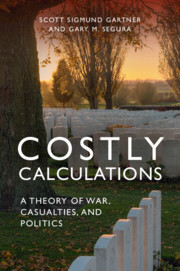Book contents
- Costly Calculations
- Costly Calculations
- Copyright page
- Dedication
- Contents
- Figures
- Tables
- Acknowledgments
- 1 Introduction
- 2 A Price Theory of War
- 3 Calculating War’s Price: What’s It Worth, and How Much Will It Cost?
- 4 The Price Theory of War in Action: Experimental Demonstrations of the Impacts of Expected Costs and Valuable War Aims
- 5 Conflict Dynamics across Space and Time: Public Opinion in the Korean and Vietnam Wars
- 6 Getting Wartime Information from Over-There to Over-Here: News Media and Social Networks
- 7 Elite Opinion Formation and Its Electoral Consequences
- 8 Conclusion: Wars, Casualties, Politics, and Policies
- Bibliography
- Index
3 - Calculating War’s Price: What’s It Worth, and How Much Will It Cost?
Published online by Cambridge University Press: 18 June 2021
- Costly Calculations
- Costly Calculations
- Copyright page
- Dedication
- Contents
- Figures
- Tables
- Acknowledgments
- 1 Introduction
- 2 A Price Theory of War
- 3 Calculating War’s Price: What’s It Worth, and How Much Will It Cost?
- 4 The Price Theory of War in Action: Experimental Demonstrations of the Impacts of Expected Costs and Valuable War Aims
- 5 Conflict Dynamics across Space and Time: Public Opinion in the Korean and Vietnam Wars
- 6 Getting Wartime Information from Over-There to Over-Here: News Media and Social Networks
- 7 Elite Opinion Formation and Its Electoral Consequences
- 8 Conclusion: Wars, Casualties, Politics, and Policies
- Bibliography
- Index
Summary
We set out an array of initial conditions for both sides of a conflict that form their levels of public support. These initial conditions result in selection effects; most wars whose initial conditions are not favorable to public support never occur and are nonevents. Miscalculations occur, and some wars whose opposition was underestimated are almost immediately unpopular. Leaders can attempt to persuade the public and shift the cost and benefit perceptions. But the selection effect is strong and as a result, support for a conflict, at least initially, is generally high. We also identified a set of factors that might vary as the war is fought. Changes in strategy, alliances (on either side), and news from the battlefield can alter the expectation of costs and the values assigned to the aims of the conflict. The war’s aims can change as well. Each of these wartime factors can shape opinion by shifting costs (ETC) and value (RP) higher or lower. We can thus identify the factors that influence individuals and consequently the aggregate shape of society’s value of a conflict ex ante within and across conflicts and that predict its impact on support given a war’s estimated costs.
Keywords
- Type
- Chapter
- Information
- Costly CalculationsA Theory of War, Casualties, and Politics, pp. 69 - 91Publisher: Cambridge University PressPrint publication year: 2021



